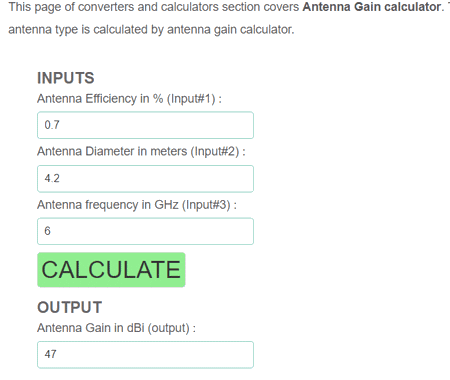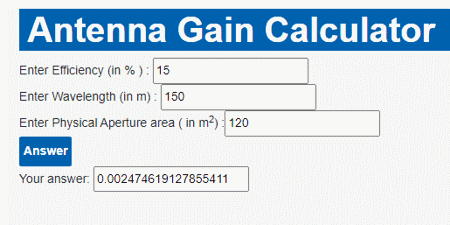10 Best Free Online Antenna Gain Calculator Websites
Here is a list of best free online antenna gain calculator websites. Antenna Gain is an important concept of RF (Radio Frequency) field. It is used to measure the amount of boost an antenna can provide to a signal in a certain direction compared to an isometric antenna (it emits radiation equally in all directions). Antenna gain is mainly measured in dB (decibel) and dBi (decibels relative to an isotropic radiator) units. To calculate the exact gain of an antenna, users can check out these online antenna gain calculator websites.
Using these websites, users can quickly find out the antenna gain value. Most of these website calculates antenna gain values for parabolic reflector or parabolic antennas. To calculate the antenna gain, these calculators require some input values such as Antenna Efficiency, Antenna diameter, Antenna Frequency, etc. Besides antenna gain, some calculators can also find out the beam width of an antenna using the same set of input values. Before starting the calculation process, users can specify the antenna frequency unit (Hz, MHz, kHz, or GHz) in most calculators. To help out users, I have included the antenna gain calculation steps in the description of each website.
These calculators also offer additional tools like Frequency Calculator, Antenna Beamwidth Coverage Calculator, UHF Antenna Length Calculator, etc. Go through the list to know more about these websites.
My Favorite Online Antenna Gain Calculator Website:
byjus.com is my favorite website because it can calculate Antenna Gain in dBi or decibel isotropic unit. Plus, it shows the formula that it uses to perform the calculation. It also provides steps to use its antenna gain calculator tool.
You can also check out the lists of best free Online Helical Antenna Design Calculator, Online Dipole Antenna Calculator, and Online Noise Figure Calculator websites.
Comparison Table:
| Features/Website Names | Shows antenna gain calculation formula | Provides calculation steps | Can calculate antenna gain in dBi (isotropic dipole gain) unit |
|---|---|---|---|
| byjus.com | ✓ | ✓ | ✓ |
| everythingrf.com | ✓ | x | x |
| rfwireless-world.com | ✓ | x | ✓ |
| ahsystems.com | ✓ | x | ✓ |
| meracalculator.com | ✓ | x | x |
| satellite-calculations.com | x | x | x |
| qsl.net | x | x | ✓ |
| 3roam.com | ✓ | x | ✓ |
| cleariitmedical.com | x | ✓ | x |
| calculator.academy | ✓ | ✓ | x |
byjus.com

byjus.com is a free online antenna gain calculator website. This website comes with a simple antenna gain calculator tool that uses antenna efficiency, wavelength, and physical aperture area values to calculate the antenna gain in dBi unit. Besides calculating the antenna gain, it can also be used to calculate the antenna efficiency, antenna wavelength, and physical aperture area values. It also shows the formula that it uses to calculate the antenna gain values. An explanation of antenna gain and steps to use this calculator are also provided by it. Now, follow the below steps.
How to calculate antenna gain online using byjus.com:
- Visit this website using the given link.
- After that, enter the required input values namely efficiency, wavelength, and physical aperture area.
- Next, enter “x” in the Antenna Gain field.
- Finally, click on the Calculate ‘x’ button to start the calculation process.
Additional Features:
- This website also comes with additional online tools such as Matrix Calculator, variance Calculator, Roots Calculator, Additive Inverse Calculator, and more.
Final Thoughts:
It is one of the best free online antenna gain calculator websites through which users can accurately calculate the antenna gain value.
| Pros | Cons |
|---|---|
| Shows the antenna gain calculation formula | |
| Provides calculation steps |
everythingrf.com

everythingrf.com is a free online antenna gain calculator website. Using this website, users can calculate the gain of a parabolic reflector antenna using its diameter and frequency. The antenna frequency value can be entered in Hz, KHz, MHz, and GHz units. Apart from gain can also be used to calculate the wavelength of an antenna. It also shows the formula that it uses to calculate the antenna gain. Now, follow the below steps.
How to calculate antenna gain online using everythingrf.com:
- Visit this website and access the Parabolic Reflector Antenna Gain Calculator.
- Now, enter the antenna diameter and frequency values.
- Next, specify the units of both diameter and frequency values.
- Finally, click on the Calculate button to view the calculated antenna gain and wavelength values.
Additional Features:
- This website also offers additional antenna calculators such as line of sight, whip antenna, helical antenna design, microstrip path, and more.
Final Thoughts:
It is a good online antenna gain calculator website that uses antenna diameter and frequency values to find out the antenna gain.
| Pros | Cons |
|---|---|
| Can calculate both antenna gain and wavelength values |
rfwireless-world.com

rfwireless-world.com is another free online antenna gain calculator website. Through this website, users can calculate the gain of parabolic antennas. To do that, it requires three input values from users namely Antenna Efficiency in percentage, Antenna Diameter in meters, and Antenna frequency in GHz. After performing the calculation, it shows the Antenna gain in dBi unit. This website also shows and explains the antenna gain calculation equation. Now, follow the below steps.
How to calculate antenna gain online using rfwireless-world.com:
- Visit this website and access the Antenna Gain Calculator.
- After that, enter the antenna efficiency percentage, antenna diameters in meters, and antenna frequency in GHz units.
- Next, click on the Calculate button to start the calculation process.
- Finally, view the antenna gain value in dBi (decibels per isotropic) unit.
Additional Features:
- This website also offers additional online calculators such as RF Link Budget, Resonant Frequency Calculator, Radar Range Resolution, Radio Horion Calculator, and more.
Final Thoughts:
It is another good online antenna gain calculator website through which users can calculate the antenna gains of any parabolic antenna.
| Pros | Cons |
|---|---|
| Can calculate antenna gain of parabolic antennas | |
| Shows antenna gain calculation equation |
ahsystems.com

ahsystems.com is another free online antenna gain calculator website. Users can use this website to calculate antennas’ isotropic dipole gain (dBi) and numeric gain values. It requires Frequency in MHz and Antenna Factor values to perform these calculations. It also shows the formulas it uses to calculate both gain values. Apart from gain, it can also be used to calculate the Antenna Factor value. Now, follow the below steps.
How to calculate antenna gain online using ahsystems.com:
- Go to this website using the given link.
- After that, enter the Frequency and Antenna Factor values.
- Next, view the calculated Gain (dBi) and Gain (numeric) values.
Additional Features:
- This website also contains tools to perform field strength calculation, dBm to Volts to Watts conversion, half power beamwidth coverage calculation, and more.
Final Thoughts:
It is another simple online antenna gain calculator website that anyone can use to calculate both dBi and numeric antenna gain values.
| Pros | Cons |
|---|---|
| Can calculate both numeric and isotropic dipole gain values | |
| Shows calculation formulas |
meracalculator.com

meracalculator.com is another free online antenna gain calculator website. Through this website, users can quickly the antenna gain value of an antenna. It requires three antenna values to calculate the antenna gain namely Efficiency, Wave Length, and Physical Aperture Area. It also shows the formula that it uses to calculate the antenna gain. In addition to that, it also offers multiple examples highlighting the antenna gain calculation process. Now, check out the below steps.
How to calculate antenna gain online using meraclaculator.com:
- Visit this website using the given link.
- After that, enter the Antenna Efficiency, Wavelength, and physical Aperture Area values.
- Next, click on the Calculate button to start the calculation process.
- Finally, view the calculated antenna gain value.
Additional Features:
- This website also comes with additional calculators such as dipole antenna, planet weight, ohms law current, cylindrical capacitor, and more.
Final Thoughts:
It is another capable online antenna gain calculator website that anyone can use without much hassle.
| Pros | Cons |
|---|---|
| Shows calculation process using examples | |
| Shows antenna gain calculation formula |
satellite-calculations.com

satellite-calculations.com is another free online antenna gain calculator website. It is another good website through which users can calculate the antenna gain of parabolic antennas. Apart from antenna gain, it can also calculate the beamwidth values. To calculate the antenna gain, it requires four input values namely Antenna Diameter, Antenna Efficiency, Rx Frequency, and Wavelength. Now, follow the below steps.
How to calculate antenna gain online using satellite-calculations.com:
- Visit this website using the provided link.
- After that, enter all the required input values.
- Next, press the enter button to view the calculated antenna gain and beam width values.
Additional Features:
- This website also contains tools like sun position calculator, moon position calculator, sun transit calculator, etc.
Final Thoughts:
It is a simple and effective online antenna gain calculator website that can also be used to calculate the beam width values.
| Pros | Cons |
|---|---|
| Can also calculate beamwidth values | Doesn’t show the calculation formula |
| Lacks information explaining the antenna gain |
qsl.net

qsl.net is yet another free online antenna gain calculator website. Through this website, users can calculate the gain of a parabolic antenna in dBi or decibel per isotropic unit. Although, it doesn’t provide any information related to antenna gain. Plus, it also lacks the antenna gain calculation formula. Now, check out the below steps.
How to calculate antenna gain online using qsl.net:
- Launch this website using the given link.
- After that, enter the antenna diameter and frequency values.
- Finally, click on the Calculate button to view the calculated gain in dBi unit.
Additional Features:
- This website also contains additional online tools such as path loss in free space for space communications, the K-factor of an antenna, field strength of a transmitter, etc.
Final Thoughts:
It is another simple online antenna gain calculator website through which users can calculate the antenna gain of parabolic antennas.
| Pros | Cons |
|---|---|
| Doesn’t show the calculation formula | |
| Lacks information related to antenna gain |
3roam.com

3roam.com is another free online antenna gain calculator website. This website allows users to calculate antenna gain in both the numeric gain and dBI gain units. To calculate the antenna gain, it uses the Antenna Factor and Antenna Frequency values. The antenna frequency can be entered in Hz, kHz, MHz, and GHz units. This website also provides antenna gain calculation formulas and examples of antenna gain calculation. Now, follow the below steps.
How to calculate antenna gain online using 3roam.com:
- Visit this website and access the Antenna Gain Calculator.
- After that, enter the Antenna Factor and Frequency values.
- Now, specify the unit of frequency.
- In the end, view the calculated antenna gain value.
Additional Features:
- On this website, users can also find additional antenna gain calculators such as Antenna Range, Capacitor Dissipation, RMS Volage., and more.
Final Thoughts:
It is another good online antenna gain calculator website through which users can quickly antenna gain value.
| Pros | Cons |
|---|---|
| Provides calculation formula and calculation examples |
cleariitmedical.com

cleariitmedical.com is another free online antenna gain calculator website. This website comes with a standard antenna gain calculator. Through this calculator, users can find out the antenna gain value using three known values namely Efficiency Percentage, Wavelength, and Physical Aperture Area. It also provides steps to use this calculator. Although, it lacks information related to antenna gain. Now, follow the below steps.
How to calculate antenna gain online using cleariitmedical.com:
- Visit this website and open up the Antenna Gain Calculator.
- After that, enter all the required input values.
- Next, click on the Answer button to view the antenna gain value.
Additional Features:
- This website also come with handy tools like Ac to Dc Converter, Surface Area Calculator, Cicular Velocity Calculator, Battery Life Calculator, and more.
Final Thoughts:
It is another simple online antenna gain calculator website that anyone can use without much hassle.
| Pros | Cons |
|---|---|
| Provides steps to calculate antenna gain | Lacks information related to antenna gain |
| Doesn’t show the antenna gain calculation formula |
calculator.academy

calculator.academy is the last free online antenna gain calculator website. Like other similar websites, it also uses Antenna Efficiency, Wave Length, and Physical Aperture Area values to calculate the antenna gain. It also defines antenna gain and shows the formula that it uses to calculate the antenna gain value. To help out users, it also provides the steps to calculate antenna gain. Now, follow the below steps.
How to calculate antenna gain online using calculator.academy:
- Go to this website using the provided link.
- After that, enter the efficiency, wavelength, and physical aperture area values.
- Next, click on the Calculate button to view the calculated antenna gain.
Additional Features:
- This website also offers calculators associated with Finance, maths, Science, Engineering, and Health fields.
Final Thoughts:
It is another simple online antenna gain calculator website that also provides the steps of antenna gain calculation.
| Pros | Cons |
|---|---|
| Provides steps to calculate antenna gain | |
| Shows antenna gain calculation formula | |
| Defines antenna gain |
Frequently Asked Questions
Antenna gain is a measure of the directional performance of an antenna in a specific direction compared to a reference antenna. It quantifies the ability of an antenna to focus its radiated power in a particular direction. Antenna gain is usually expressed in decibels (dB) and is calculated using the following formula: Antenna Gain (dBi) = 10 * log10 (Pout / Pin). Where: Pout is the power radiated by the antenna in the desired direction (in the direction of maximum radiation), and Pin is the power applied to the input of the antenna.
The term "dB gain" in the context of antennas refers to the measure of how much an antenna amplifies or concentrates the signal in a particular direction compared to a reference antenna. It quantifies the directional performance of the antenna. The gain is usually expressed in decibels (dB) and is a logarithmic representation of the power or signal enhancement achieved by the antenna.
Antenna gain factor is another term for antenna gain. It refers to the measure of how much an antenna can amplify or concentrate a signal in a particular direction compared to a reference antenna, often an isotropic radiator or a dipole antenna. The gain factor quantifies the antenna's ability to focus its radiated or received power in a specific direction.
The efficiency of an antenna is typically not expressed in decibels (dB), but rather as a percentage or a decimal value. Antenna efficiency measures how effectively an antenna converts input power into radiated energy, and it takes into account losses that occur in the antenna system. These losses can be due to various factors such as conductor resistance, dielectric losses, and mismatch losses.
RX gain, also known as receive gain, refers to the amplification or sensitivity of a receiver system, such as a radio or communication device, in receiving and detecting weak signals. It's a measure of how effectively the receiver can pick up and process incoming signals. RX gain is usually expressed in decibels (dB) and indicates the ratio of the output voltage or power of the receiver to the input voltage or power of the received signal. A higher RX gain value implies that the receiver is more sensitive and can amplify weak signals more effectively, which is particularly important when dealing with low-level or distant signals.
Antenna gain is important for several reasons in various applications involving wireless communication, radar systems, radio astronomy, and more. Here are some key reasons why antenna gain is important: Signal Strength: Antenna gain allows for the concentration of radiated or received power in a specific direction. This results in higher signal strength in the desired direction, which is crucial for establishing reliable communication links over longer distances or in environments with signal obstacles. Longer Communication Range: In wireless communication systems, higher antenna gain enables signals to be transmitted over greater distances without the need for significantly higher transmitter power. This is particularly valuable for applications like long-range communication, satellite communication, and point-to-point links. Reduced Interference: Directional antennas with higher gain can help reduce interference from unwanted signals or noise coming from directions other than the intended communication path. This improves signal quality and reduces the likelihood of data errors. Increased Sensitivity: In receiving applications, higher antenna gain enhances the sensitivity of the receiver, allowing it to detect weaker signals. This is crucial for applications such as radio astronomy, remote sensing, and low-power wireless devices.
Naveen Kushwaha
Passionate about tech and science, always look for new tech solutions that can help me and others.
About Us
We are the team behind some of the most popular tech blogs, like: I LoveFree Software and Windows 8 Freeware.
More About UsArchives
- May 2024
- April 2024
- March 2024
- February 2024
- January 2024
- December 2023
- November 2023
- October 2023
- September 2023
- August 2023
- July 2023
- June 2023
- May 2023
- April 2023
- March 2023
- February 2023
- January 2023
- December 2022
- November 2022
- October 2022
- September 2022
- August 2022
- July 2022
- June 2022
- May 2022
- April 2022
- March 2022
- February 2022
- January 2022
- December 2021
- November 2021
- October 2021
- September 2021
- August 2021
- July 2021
- June 2021
- May 2021
- April 2021
- March 2021
- February 2021
- January 2021
- December 2020
- November 2020
- October 2020
- September 2020
- August 2020
- July 2020
- June 2020
- May 2020
- April 2020
- March 2020
- February 2020
- January 2020
- December 2019
- November 2019
- October 2019
- September 2019
- August 2019
- July 2019
- June 2019
- May 2019
- April 2019
- March 2019
- February 2019
- January 2019
- December 2018
- November 2018
- October 2018
- September 2018
- August 2018
- July 2018
- June 2018
- May 2018
- April 2018
- March 2018
- February 2018
- January 2018
- December 2017
- November 2017
- October 2017
- September 2017
- August 2017
- July 2017
- June 2017
- May 2017
- April 2017
- March 2017
- February 2017
- January 2017
- December 2016
- November 2016
- October 2016
- September 2016
- August 2016
- July 2016
- June 2016
- May 2016
- April 2016
- March 2016
- February 2016
- January 2016
- December 2015
- November 2015
- October 2015
- September 2015
- August 2015
- July 2015
- June 2015
- May 2015
- April 2015
- March 2015
- February 2015
- January 2015
- December 2014
- November 2014
- October 2014
- September 2014
- August 2014
- July 2014
- June 2014
- May 2014
- April 2014
- March 2014








